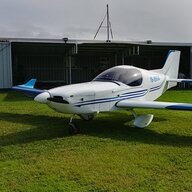The whole system is bullshit. Your drivers licence provides sufficient ID for almost any thing else in the country except landing at some remote aerodrome that has decided it needs a security fence and ASIC clearance. What idiot came up with the ASIC requirement for my friends wife to renew it in he maiden name that she hasn't used for 20 years and every other bit of ID she has is in her married name.
The stupidity of the requirement and the process is highlighted by the letter below.
Dear Mr. Minister,
I ' m in the process of renewing my passport, and still cannot believe this.
How is it that K-Mart has my address and telephone number, and knows
that I bought a television set and golf clubs from them back in 1997,
and yet the Federal Government is still asking me where I was born
and on what date?
For Christ sakes, do you guys do this by hand?
My birth date you have in my Medicare information, and it is on all the income tax forms I've filed for the past 40 years. It is also on my driver ' s licence, on the last eight passports I've ever had, on all those stupid customs declaration forms I've had to fill out before being allowed off planes over the past 30 years. It's also on all those insufferable census forms that I've filled out every 5 years since 1966.
Also... would somebody please take note, once and for all, that my mother ' s name is Audrey, my father 's name is Jack, and I'd be absolutely ****ing astounded if that ever changed between now and when I drop dead!!!...
****! What do you people do with all this information we keep having to provide??
I apologise, Mr. Minister. But I'm really ****ed off this morning. Between you and me, I've had enough of all this bull****! You send the application to my house, then you ask me for my ****ing address!! What the hell is going on with your mob? Have you got a gang of mindless Neanderthal arseholes working there!
And another thing, look at my damn picture... Do I look like Bin Laden?
I can't even grow a beard for God's sakes. I just want to go to New Zealand and see my new granddaughter. (Yes, my son interbred with a Kiwi girl). And would someone please tell me, why would you give a **** whether or not I plan on visiting a farm in the next 15 days? In the unlikely event I ever got the urge to do something weird to a sheep or a horse, believe you me, I'd sure as hell not want to tell anyone!
Well, I have to go now, cause I have to go to the other end of the city, and get another ****ing copy of my birth certificate - and to part with another $80 for the privilege of accessing MY OWN INFORMATION!
Would it be so complicated to have all the services in the same spot, to assist in the issuance of a new passport on the same day??
Nooooo.. that'd be too ****ing easy and makes far too much sense. You would much prefer to have us running all over the place like chickens with our ****ing heads cut off, and then having to find some ' high-society ' wanker to confirm that it 's really me in the goddamn photo! You know the photo... the one where we're not allowed to smile?! .... you ****ing morons.
Signed - An Irate Australian Citizen.
P.S. Remember what I said above about the picture, and getting someone in ' high-society ' to confirm that it's me? Well, my family has been in this country since before 1850! In 1856, one of my forefathers took up arms with Peter Lalor. (You do remember the Eureka Stockade!!)
I have also served in both the CMF and regular Army for something over 30 years (I went to Vietnam in 1967), and still have high security clearances. I'm also a personal friend of the president of the RSL... and Lt General Peter Cosgrove sends me a Christmas card each year.
However, your rules require that I have to get someone "important" to verify who I am; You know... someone like my doctor - WHO WAS BORN AND RAISED IN ****ING PAKISTAN !!!..... a country where they either assassinate or hang their ex-Prime Ministers - and are suspended from the Commonwealth for not having the "right sort of government".
You are all ****ing idiots!









